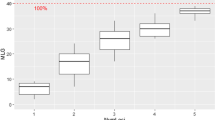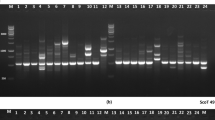Abstract
Zombi pea (Vigna vexillata (L.) A. Rich) is an underutilized legume species and a useful gene source for resistance to biotic and abiotic stresses, although there is little understanding on its genetic diversity and structure. In this study, 422 (408 wild and 14 cultivated) accessions of zombi pea from diverse origins (201 from Africa, 126 from America, 85 from Australia, 5 from Asia and 5 from unknown origin) were analyzed with 20 simple sequence repeat (SSR) markers to determine its genetic diversity and genetic structure. The SSR markers detected 273 alleles in total with a mean of 13.6 alleles per locus. Polymorphism information content values of the markers varied from 0.58 to 0.90 with an average of 0.76. Overall gene diversity was 0.715. Gene diversity and average allelic richness was highest in Africa (0.749 and 8.08, respectively) and lowest in America (0.435 and 4.10, respectively). Nei’s genetic distance analysis revealed that the highest distance was between wild Australia and cultivated Africa (0.559), followed by wild West Africa and wild Australia (0.415). STRUCTURE, neighbor-joining (NJ), and principal coordinate analyses consistently showed that these zombi pea accessions were clustered into three major groups, viz. America, Africa and Asia, and Australia. NJ tree also suggested that American and Australian accessions are originated from East African zombi peas, and that the cultivated accessions from Africa and Asia were genetically distinct, while those from America were clustered with some cultivated accessions from Africa. These results suggest that Africa is the center of origin and diversity of zombi pea, and that domestication of this pea took place more than once in different regions.



Similar content being viewed by others
References
Anderson JA, Churchill GA, Autrique JE, Tanksley SD, Sorrells ME (1993) Optimizing parental selection for genetic linkage maps. Genome 36(1):181–186
Asati BS, Yadav DS (2004) Diversity of horticultural crops in north eastern region. ENVIS Bull Himal Eco 12:1–11
Bhattacharyya PK, Ghosh AK, Sanyal B, Deb Ray G (1984). Grow Vigna vexillata for protein-rich tuber-cum-pulse crop in North-eastern hill region Seeds Farms 10:33–36
Birch ANE, Fellow LE, Evans SV, Doherty K (1986) Para-Aminophenylalanine in Vigna : possible taxonomic and ecological significance as a seed defence against bruchids. Phytochemistry 25(12):2745–2749
Chaitieng B, Kaga A, Tomooka N, Isemura T, Kuroda Y, Vaughan DA (2006) Development of a black gram [Vigna mungo (L.) Hepper] linkage map and its comparison with an azuki bean [Vigna angularis (Willd.) Ohwi and Ohashi] linkage map. Theor App Genet 113:1261–1269
Chandel KPS, Arora RK, Joshi BS (1972) Vigna capensis Walp. (V. vexillata) an edible root legume. Curr Sci 41:537
Chankaew S, Isemura T, Isobe S, Kaga A, Tomooka N, Somta P, Hirakawa H, Shirasawa K, Vaughan DA, Srinives P (2014) Detection of genome donor species of neglected tetraploid crop Vigna reflexo-pilosa (créole bean) and genetic structure of diploid species based on newly developed EST-SSR markers from azuki bean (Vigna angularis). PLoS One. doi:10.1371/journal.pone.0104990
Damayanti F (2010) Comparativestudies on cultivated and wild accessions of Vigna vexillata (L.) A. Rich. Masters (Research) Thesis, James Cook University
Damayanti F, Lawn RJ, Bielig LM (2010) Genotypic variation in domesticated and wild accessions of the tropical tuberous legume Vigna vexillata (L.) A. Rich. Crop Pasture Sci 61(10):771–784
Duke JA (1981) Vigna unguiculata (L.) Walp. spp. unguiculata. In: Okeson ON (ed) Legumes of world economic importance. Plenum Press, New York, pp 303–305
Evanno G, Regnaut S, Goudet J (2005) Detecting the number of clusters of individuals using the software STRUCTURE: a simulation study. Mol Ecol 14:2611–2620
Ferguson H (1954) The food crops of the Sudan and their relation to environment. In: A paper presented at the 1953 Conference of the Philosophical Society of the Sudan on “Foodand Society in the Sudan”, Philosophical Society of the Sudan Khartoum, McCorquodaleand Co. (Sudan), Ltd
Garba M, Pasquet RS (1997) Isozyme diversity in Vigna vexillata (L.) A. Rich (Fabaceae) complex. S Afr J Bot 64(3):163–175
Garba M, Pasquet RS (1998) The Vigna vexillata (L.) A. Rich. genepool. In: Sorensen M, Estrella JE, Hammann OJ, Rios Ruiz SA (eds) 2nd International symposium on tuberous legume. 5–8 August 1996. Celaya, Mexico, pp 61–71
Gomathinayagam P, Ganesh Ram S, Rathnaswamy R, Ramaswamy NM (1998) Interspecific hybridization between Vigna unguiculata (L.) Walp. and V. vexillata (L.) A. Rich. through in vitro embryo culture. Euphytica 102:203–209
Gupta SK, Gopalakrishna T (2010) Development of unigene-derived SSR markers in cowpea (Vigna unguiculata) and their transferability to other Vigna species. Genome 53(7):508–523
Jaaska V (2001) Isoenzyme diversity and phylogenetic relationships among the American beans of the genus Vigna Savi (Fabaceae). Biochem Syst Ecol 29:1153–1173
Jackai LEN, Oghiakhe S (1989) Pod wall trichomes and resistance of two wild cowpea, Vigna vexillata, accessions to Maruca testualis (Geyer) (Lepidoptera: Pyralidae) and Clavigralla tomentosicollis Stal (Hemiptera: Coreidae). B Entomol Res 79:595–605
Kaewwongwal A, Kongjaimun A, Somta P, Chankaew S, Yimram T, Srinives P (2015) Genetic diversity of the black gram [Vigna mungo (L.)] gene pool as revealed by SSR markers. Breed Sci 65:127–137
Karuniawan A, Iswandi A, Kale PR, Heinzemann J, Grüneberg WJ (2006) Vigna vexillata (L.) A. Rich. cultivated as a root crop in Bali and Timor. Genet Resour Crop Evol 53(1):213–217
Kongjaimun A, Kaga A, Tomooka N, Somta P, Shimizu T, Shu Y, Isemura T, Vaughan DA, Srinives P (2012) An SSR-based linkage map of yardlongbean (Vigna unguiculata (L.) Walp. subsp. unguiculata Sesquipedalis group) and QTL analysis of pod length. Genome 55(2):81–92
Lawn RJ, Cottrell A (1988) Wild mungbean and its relatives in Australia. Biologist (London) 35:267–273
Lawn RJ, Watkinson AR (2002) Habitats, morphological diversity and distribution of the genus Vigna Savi in Australia. Aust J Agri Res 53:1305–1316
Lewis GP, Shrine B, Mackinder B, Lock JM (2004) Legumes of the world. Royal Botanical Garden, Kew, London
Li CD, Fatokun CA, Ubi B, Singh BB, Scoles GJ (2001) Determining genetic similarities and relationships among cowpea breeding lines and cultivars by microsatellite markers. Crop Sci 41(1):189–197
Lodhi MA, Ye GN, Weeden NF, Reisch BI (1994) A simple and efficient method for DNA extraction from grapevine cultivars and Vitis species. Plant MolBiol Rep 12:6–13
Maréchal R, Mascherpa JM, Stainier F (1978) Etude taxonomique d’un grouped’especes des genres Phaseolus et Vigna (Papilonaceae) sur la base des donneesmorphologiques et polliques, traitees pour l’analyseinformatique. Boissiera 28:1–273
Maxted N, Mabuza-Diamini P, Moss H, Padulosi S, Jarvis A, Guarino L (2004) An ecogeographic study: African Vigna, systematic and ecogeographic studies of crop genepool 10. International Plant Genetic Resources Institutes, Rome, Italy
Miller IL, Williams WT (1980) Tolerance of some tropical legume to six months of simulated waterlogging. Trop Grasslands 15:39–43
Nei M, Tajima F, Tateno Y (1983) Accuracy of estimated phylogenetic trees from molecular data. J MolE 19:153–170
Pasquet RS (2000) Allozyme diversity of cultivated cowpea Vigna unguiculata (L.) Walp. Theor Appl Genet 101:211–219
Pasquet RS (2001) Vigna Savi. In: Mackinder B, Pasquet R, Polhill R, Verdcourt B (eds) Flora Zambesiaca, volume part Phaseoleae. Royal Botanic Gardens Kew, London, pp 121–156
Pienaar BJ, Kok PDF (1991) The Vigna vexillata complex (Fabaceae) in Southern Africa. S Afri J Bot 57:236–245
Piergiovanni AR (1998) Vigna vexillata (L.) A. Rich. seed protein: heterogeneity in subunits of globulin fraction. Genet Resour Crop Evol 45:97–103
R Development Core Team (2013) R: A language and environment for statistical computing. R Foundation for Statistical Computing, Vienna
Roecklein JC, Leung P (1987) A profile of economic plants. Transaction Publishers, USA
Sangiri C, Kaga A, Tomooka N, Vaughan DA, Srinives P (2007) Genetic diversity of the mungbean (Vigna radiata, Leguminosae) genepool on the basis of microsatellite analysis. Aus J Bot 55:837–847
Sasikumar B, Sardana S (1988) Vigna vexillata (Fabaceae), A pulse cum tuber crop of northeastern hill region of India. Econ Bot 42:292
Somta P, Mucsh W, Kongsamai B, Chanprame S, Nakasathien S, Toojinda T, Sorajjapinu W, Seehalak W, Tragoonrung S, Srinives P (2008) New microsatellite markers isolated from mungbean (Vigna radiata (L.) Wilczek). Mol Ecol Res 8(5):1155–1157
Somta P, Seehalak W, Srinives P (2009) Development, characterization and cross-species amplification of mungbean (Vigna radiata) genic microsatellite markers. Conserv Genet 10:1939–1943
Spinosa A, Pignone D, Sonnante G (1998) Assessment of genetic variation in a working collection of Vigna vexillata (L.) A. Rich. by isozyme and RAPD analyses. Genet Resour Crop Evol 45:347–354
Takahashi Y, Somta P, Muto C, Iseki K, Naito K, Pandiyan M, Natesan S, Tomooka N (2016) Novel genetic resources in the genus Vigna unveiled from gene bank accessions. PLoS One 11(1):e0147568. doi:10.1371/journal.pone.0147568
Tamura K, Stecher G, Peterson D, Filipski A, Kumar S (2013) MEGA6: molecular evolutionary genetics analysis version 6.0. MolBiolE 30:2725–2729
Tangphatsornruang S, Somta P, Uthaipaisanwong P, Chanprasert J, Sangsrakru D, Seehalak W, Sommanas W, Tragoonrung S, Srinives P (2009) Characterization of microsatellites and gene contents from genome shotgun sequences of mungbean (Vigna radiata (L.) Wilczek). BMC Plant Biol 9:137. doi:10.1186/1471-2229-9-137
Thottappilly G, Ng NQ, Russel HW (1994) Screening germplasm of Vigna vexillata for resistance to cowpea mottle virus. Int J Trop Plant Dis 12:75–80
Tian J, Isemura T, Kaga A, Vaughan DA, Tomooka N (2013) Genetic diversity of the rice bean (Vigna umbellata) genepool as assessed by SSR markers. Genome 56:717–727
Tomooka N, Vaughan DA, Moss H, Maxted N (2002) The Asian Vigna: genus Vigna subgenus Ceratotropis genetic resources. Kluwer Academic Publishers, Dordrecht
Tomooka N, Kaga A, Isemura T, Vaughan DA, Srinives P, Somta P, Thadavong S, Bounphanousay C, Kanyavong K, Inthapanya P, Pandiyan M, Senthil N, Ramamoorthi N, Jaiwal PK, Tian J, Umezawa K, Yokoyama T (2011) Vigna genetic resources. In The 14th NIAS International Workshop on Genetic Resources: Genetic Resources and Comparative Genomics of Legumes (Glycine and Vigna). 14 September 2009, National Institute of Agrobiological Sciences, Japan, pp 11–21
Vanderborght T (1989) Some observations on seedlings of Vigna vexillata (L.) A. Rich. (Fabaceae). Bull Jard Bot Nat Belg 59:179–187
Wang XW, Kaga A, Tomooka N, Vaughan DA (2004) The development of SSR markers by a new method in plants and their application to gene flow studies in azuki bean [Vigna angularis (Willd.) Ohwi & Ohashi]. Theor Appl Genet 109(2):352–360
Xu HX, Jing T, Tomooka N, Kaga A, Isemura T, Vaughan DA (2008) Genetic diversity of the azuki bean (Vigna angularis (Willd.) Ohwi & Ohashi) gene pool as assessed by SSR markers. Genome 51(9):728–738
Acknowledgements
This research was supported by the Royal Golden Jubilee Ph.D. Scholarship and the TRF Research Career Development Grant (RSA5880051) both of which co-funded by the Thailand Research Fund (TRF) and Kasetsart University to P. Somta and S. Dachapak.
Author information
Authors and Affiliations
Corresponding author
Electronic supplementary material
Below is the link to the electronic supplementary material.
10709_2017_9957_MOESM1_ESM.pdf
Supplementary Figure S1.A neighbor-joining tree constructed from Nei’s genetic distance (D A) showing the genetic relationship among the 422 accessions of Vigna vexillata in relation to their germination habits (epigeal and hypogeal germinations). D A was calculated from allelic data of 20 simple sequence repeat markers. (PDF 405 KB)
10709_2017_9957_MOESM2_ESM.doc
Supplementary Table S1. Name, origin and germination habit of the 422 accessions of Vigna vexillata used in this study. (DOC 497 KB)
Rights and permissions
About this article
Cite this article
Dachapak, S., Somta, P., Poonchaivilaisak, S. et al. Genetic diversity and structure of the zombi pea (Vigna vexillata (L.) A. Rich) gene pool based on SSR marker analysis. Genetica 145, 189–200 (2017). https://doi.org/10.1007/s10709-017-9957-y
Received:
Accepted:
Published:
Issue Date:
DOI: https://doi.org/10.1007/s10709-017-9957-y




